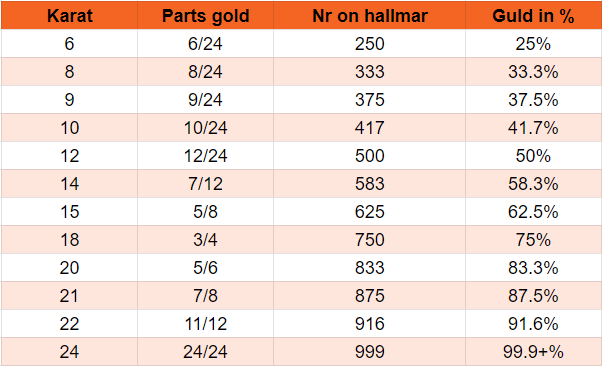
When looking for jewelry or investing in gold, it is important to understand the concept of ‘karat’ and what it means for the purity of gold. In this article, we explain what karat means and how experts measure the purity of gold to help you choose the right karat for your jewelry.

Carat is a measure of gold purity and indicates the percentage of pure gold in an alloy. The karat scale ranges from 1 to 24, with 24K representing completely pure gold (or as pure as can be obtained). At 24K, the gold content is at least 99.9%, which is known as fine gold. 24K gold is mainly used in the production of gold bars and gold coins.
Want to see the full Tavex range of 24K investment gold? Click here for more information!
Gold is a remarkably soft and valuable metal. Due to its soft properties, pure gold jewelry would be difficult to make and very fragile. To make gold jewelry harder and more durable, gold must be mixed with other metals, such as silver and copper. By mixing gold, an alloy can be created that is stronger and more durable than pure gold.
Carat levels: Carat levels indicate the purity and gold content of gold. Here are some common karat levels and their characteristics:

24 karat gold is the purest form of gold available on the market. With a purity of 99.9 percent, 24K gold is considered investment gold or pure gold. Because of its purity, 24K gold is often preferred by investors and collectors.
24K gold bars and coins are popular choices for those who want real gold of the highest purity. In industry, 24K gold is also used in certain technical applications, such as electronics and medical devices.
18 karat gold is one of the most common choices for gold jewelry. With a purity of 75%, 18K gold is made up of a significant amount of pure gold, giving the jewelry a deep and natural yellow color.
18K gold jewelry is strong, durable and perfect for everyday wear. The high purity also makes 18K gold a good choice for gold jewelry such as wedding rings and other symbolic jewelry.
14 karat gold is a popular currency for gold jewelry, especially in North America. With a purity of 58.5 percent, 14K gold is durable and less susceptible to scratching and deformation than higher karat levels. At the same time, 14K gold jewelry has a beautiful lighter yellow color, giving it a unique aesthetic appearance.
The lower purity of 14K gold also makes it slightly more affordable for those who want high-quality gold jewelry at an affordable price.
9 karat gold is the lowest karat content allowed to be sold as gold in many countries, including Sweden. With a purity of 37.5%, 9K gold is the most affordable option for those who want gold jewelry at a lower price.
9K gold jewelry has a lighter yellow color and is suitable for everyday wear. It is also important to note that 9K gold is more resistant to scratches and damage than higher karat levels, making it ideal for activewear.
To guarantee consumer confidence and ensure the authenticity of gold products, gold must be stamped with a gold hallmark indicating the karat content and purity of the gold. Gold hallmarks are common and provide you with important information when buying gold.
Gold hallmarks play a crucial role in establishing the authenticity and purity of gold products. These marks give consumers confidence and show that the gold product meets specific quality requirements. Here we take a closer look at why gold hallmarks are important and what information you can get by looking at them.

By seeing the number 18 in the image above, we can immediately determine that the ring is made of 75% gold!
By looking at gold hallmarks, you can get important information about the gold’s purity, origin and manufacturer. Here are some common types of gold hallmarks and what they represent:
Karat mark: A karat mark indicates the purity and karat content of the gold. For example, you may see marks such as ’24K’ for all-pure gold, ’18K’ for 18-karat gold, ’14K’ for 14-karat gold, and so on. The karat stamp confirms that the purity of the gold matches the stated karat content.
Read more about how Sweden’s central bank works with gold and how they mark it here!
Now that you have a better understanding of karat and its importance to the purity of gold, you can make more informed decisions when buying gold jewelry. Be sure to check the karat content and gold hallmarks to ensure you are buying real gold of the desired purity.
Remember that karat not only affects the purity of gold but also its price. Purer gold with higher karat levels tends to be more expensive than gold with lower karat levels. Therefore, choose the karat level that suits your preferences and your budget.
You can always contact Tavex if you have questions about gold or precious metals investments!
Beautiful pieces of gold jewelry often find a new home quickly. Subscribe and enjoy early access to exclusive necklaces, bracelets, and timeless treasures. Don’t miss the chance to discover the one meant for you.
We are happy to help you. Contact us or book a consultation at our office: Smalandsgatan 9, Stockholm
